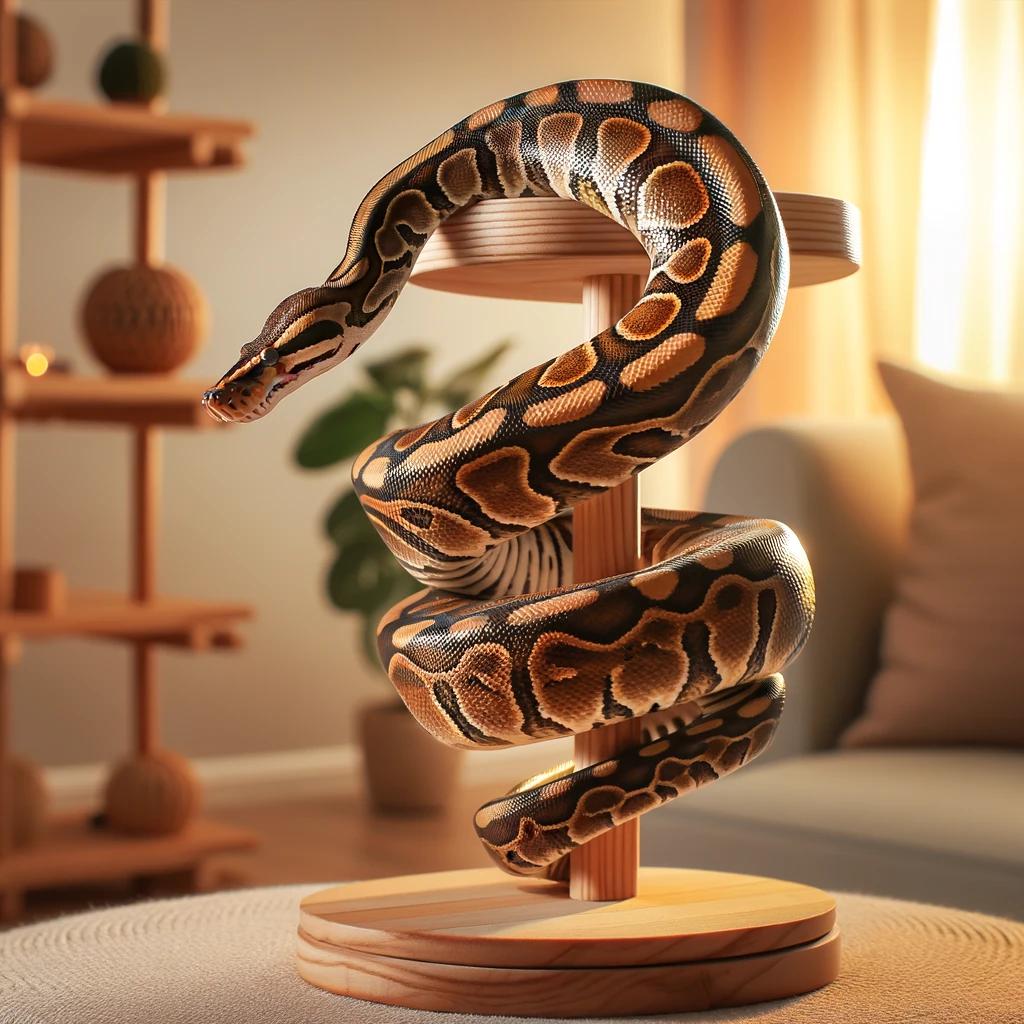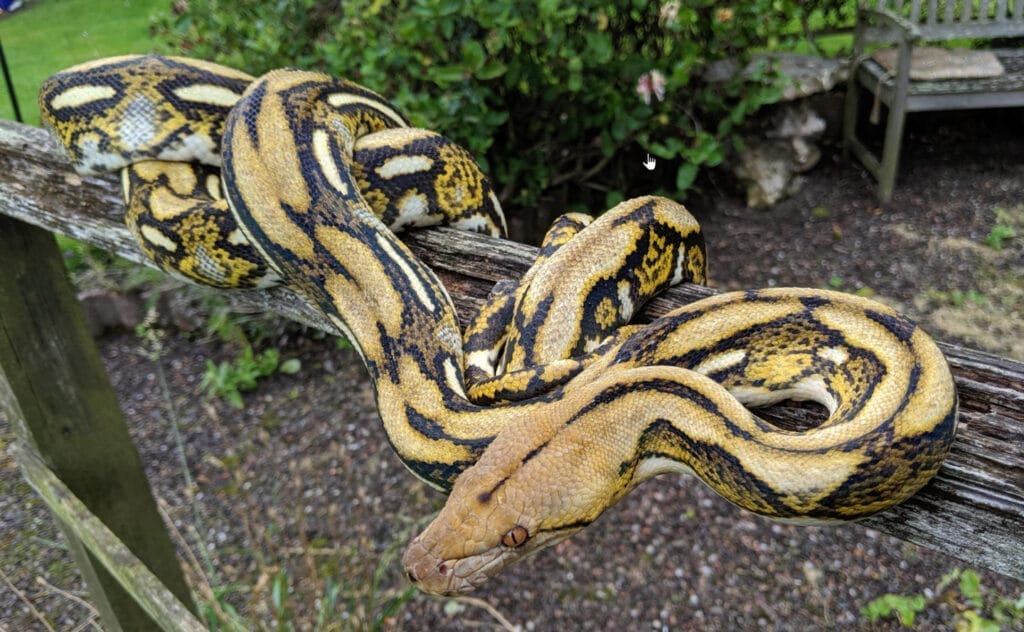Imagine turning a corner in your home to find an ancient creature gracefully sliding through its specially designed habitat. For those with a pet reticulated python, encountering one of the globe’s most magnificent and colossal serpents in their living space becomes an everyday occurrence. Having a reticulated python as a pet intertwines the complexity of their care with the awe-inspiring experience of living alongside one of nature’s most magnificent creatures.
In this exploration, we’ll meticulously unpack the essentials of fashioning a habitat that echoes their wild abode, spanning from the dimensions of their dwelling to the climatic conditions in which they thrive. We’ll also cover their dietary requirements, common health issues, and the overall commitment required. By the conclusion, you’ll understand more about whether this remarkable reptile aligns with your pet preferences.
Table Of Contents:
- AI illustration of a Clown reticulated python
- Reticulated Pythons Come in Many Varieties
- Check Local Laws and Regulations
- Understanding A Pet Reticulated Python
- Creating a Suitable Habitat at Home
- Nutritional Needs and Feeding Schedule
- Health Problems and Lifespan
- Have a Plan For 20 Years of Care
- Pros and Cons of Keeping a Reticulated Python
- Big Snake, Huge Commitment

Reticulated Pythons Come in Many Varieties
When considering adding a reticulated python to your home, it’s essential to understand the diverse array of varieties available. These magnificent creatures are known for their impressive size and wide range of patterns and colors. From popular variations that have become staples in the pet python community to rare gems that captivate enthusiasts, there’s a reticulated python out there for every level of interest.
Popular Varieties
The world of reticulated pythons is vast, with some varieties standing out due to their stunning appearances and availability. Among them:
- Albino Reticulated Python: Known for its striking white or yellow scales and red eyes, this variety is a favorite among pet owners.
- Tiger Reticulated Python: Characterized by its bold stripes that mimic those of a tiger, offering an exotic look.
- Sunfire Reticulated Python: This variety dazzles with bright colors, enhancing its natural pattern.
You can learn more about these popular types on websites like Reptiles Magazine, which provides detailed guides on care and keeping practices specific to each type.
Rare Finds: Prized by Collectors
In addition to the well-known varieties, several rare forms of reticulated pythons are prized by collectors around the globe. Some noteworthy mentions include:
- Pied Reticulated Python: Notable for its unique pattern where patches of color intersperse with areas devoid of pigment creating a ‘piebald’ effect.
- Super Dwarf Reticulated Python: A much smaller version than its larger counterparts.
Check Local Laws and Regulations
Owning a reticulated python is not as straightforward as adopting more common pets like dogs or cats. Before you consider bringing one of these magnificent reptiles into your home, it’s imperative to familiarize yourself with the local laws and regulations governing exotic pet ownership in your area. This section will guide you through understanding these legalities to ensure that your potential pet does not become an illegal inhabitant.
Why Legal Knowledge Is Essential
The legality of owning a reticulated python varies significantly from one jurisdiction to another due to concerns about safety, ecology, and public health. In some places, specific permits may be required; in others, pythons might be banned outright. Failure to comply with local regulations can lead to fines, confiscation of the animal, or even criminal charges.
Finding Reliable Information on Pet Ownership Laws
- Contact Local Wildlife Authorities: The first step should always involve contacting local wildlife agencies or fish and game departments directly. They provide authoritative information on what species are allowed and under what conditions.
- Consult Reptile Associations: Organizations dedicated to herpetology or reptile enthusiasts often have resources detailing state-by-state guidelines for reptile ownership. For example, United States Association of Reptile Keepers (USARK), offers insights into current legislation affecting reptile owners nationwide.
- Civic Resources: Your city hall or municipal website may have sections devoted specifically to pet ownership rules within city limits, which could include specifics about exotic pets like pythons.
Becoming well-informed about the legal requirements for keeping a reticulated python at home protects both you as an owner and ensures the welfare of your prospective pet. By taking proactive steps towards compliance with local laws before purchasing such an extraordinary creature, you contribute positively toward responsible exotic pet ownership—a crucial aspect when considering animals that demand specialized care beyond traditional domesticated pets.
Understanding A Pet Reticulated Python
Reticulated pythons are not your typical pet snake. Owning one of these serpentine giants necessitates a vast expanse for them to roam and an unwavering commitment from those who choose to care for them. Imagine having a creature in your home that can grow up to 20 feet long; it’s like living with a scaly roommate who never pays rent.
In their natural Southeast Asian rainforest homes, these colossal beings flourish, freely scaling trees and navigating waters. Bringing such an adventurous spirit into your home means you need to mimic their natural habitat as much as possible. This involves setting up a large enclosure with plenty of climbing opportunities and a sizable water feature for them to soak in.
Even though they’re pretty big, reticulated pythons are super intriguing because of their cool behaviors, which really draws in those who’ve been around reptiles for a while. Reticulated pythons, with their distinct coloration and sharp wits, eventually come to identify those who tend to them. But remember handling requires caution due to their strength and potential size.
Creating a Suitable Habitat at Home
Making your home fit for a reticulated python isn’t just about space; it’s about creating an environment that mirrors their natural habitat as closely as possible. Here, we’ll break down the essentials: enclosure size, temperature regulation, humidity needs, and enrichment activities.
Enclosure Size
Securing a roomy habitat is paramount for these sizable serpents. To move freely, an adult reticulated python requires an enclosure that’s at least twice its length in width and depth. Smaller enclosures work for juveniles, but remember, they grow fast. A good rule of thumb is starting with a 10-gallon tank and upgrading as they grow.
Temperature Regulation
To flourish, reticulated pythons demand environments that bask in warmth. Set up a gradient heat source to mimic day-night cycles ranging from 75°F on the cool side to 92°F under the basking spot. Use digital thermometers to monitor these temperatures accurately.
Humidity Needs
Aim for 60-80% humidity in its enclosure to keep your python healthy, using hygrometers for precise measurement. Misting systems or shallow water bowls can help maintain this level without making the substrate soggy.
Amazon has everything you need to set up a suitable habitat.
Nutritional Needs and Feeding Schedule
Feeding your reticulated python isn’t just about keeping them full; it’s about mirroring the variety they’d get in the wild. Think of their diet as a buffet that changes with each meal. They thrive on a menu featuring rats, rabbits, and chickens – all whole prey to satisfy their carnivorous appetite.
How often do you feed your slithery friend? It varies with age. Juveniles need a meal every 5-7 days, but as they grow into their impressive adult size, this stretches out to once every 3-4 weeks. Keeping an eye on their scale numbers is crucial to avoid the risk of them getting too chubby, which is pretty important.
Switching up their diet wards off nutrient shortages and makes mealtime more engaging for you and your slithering companion. But sometimes challenges pop up, like refusal to eat frozen-thawed prey after being used to live meals (Reptiles Magazine). Patience and persistence are your best tools here.
Health Problems and Lifespan
Reticulated pythons, while hardy, face several health issues in captivity. One common problem is respiratory infections due to improper humidity levels. Ensuring their habitat mimics the high humidity of their natural environment can prevent this.
Additionally, the challenge of weight gain stems from excessive feeding, particularly when it involves oversized or overly rich rodent meals. A balanced diet and regular feeding schedule keep them lean and mean. Parasites pose a threat, but maintaining a clean enclosure helps fend off unwanted guests.
Their lifespan under optimal python care conditions spans an impressive 20 to 30 years. Committing to this extended period of care demands decades of dedication and fosters a deep, enduring connection with these remarkable beings.
To avoid unexpected health costs, check out Pet Assure Mint.
Have a Plan For 20 Years of Care
When welcoming a reticulated python into your home, you must understand that you’re making a commitment that could span two decades or more. These magnificent creatures are not only one of the longest snakes in the world but also have specific needs that must be met throughout their lifetime.
Understanding Their Lifespan and Growth
Reticulated pythons can live for over 20 years in captivity with proper care. They grow rapidly during their first few years, potentially reaching lengths of up to 20 feet or more. This growth necessitates frequent upgrades to their living environment—a crucial factor prospective owners must plan for from the outset.
Crafting A Safe Environment
Your pet’s habitat should mimic its natural surroundings as closely as possible, which means investing in large enclosures equipped with appropriate heating, humidity controls, and enrichment opportunities. Ensuring this space evolves alongside your snake; what works for a juvenile will not suffice for an adult reticulated python. Here’s how you can set up an ideal enclosure.
Dietary Needs Through The Years
- Juvenile Stage: Young pythons eat every 5-7 days.
- Adult Stage: Their feeding schedule is reduced to once every two weeks or so.
Their diet primarily consists of rodents and rabbits proportionate to the snake’s size—another aspect where planning ahead becomes critical as larger prey means higher costs.
Safety Considerations For All Ages
A full-grown reticulated python requires careful handling; they are powerful animals capable of inflicting harm if provoked or mishandled. Always supervise interactions between your python and others, especially children and other pets. Learn more about reptile safety here. Preparing family members on how to interact safely with these majestic creatures is paramount for preventing accidents.
In essence, owning a reticulated python is rewarding and challenging—it demands foresight, preparation, and dedication far beyond initial adoption. By understanding their long-term needs—from housing adjustments through dietary changes—you’ll provide them with a healthy life while ensuring safety within your household.
Pros and Cons of Keeping a Reticulated Python
Owning a reticulated python is not for the faint-hearted. It’s like having a living, breathing piece of art that requires constant attention and care. However, for those willing to embrace the challenge, this unique pet provides incomparable satisfaction and a distinct companionship.
The Pros: Unique Companionship and Learning Opportunities
Reticulated pythons offer an unmatched experience in pet ownership. Their intelligence and unique behavior patterns provide endless fascination. Enthusiasts of the scaly kind might find themselves beaming with pride over these majestic beings, captivated by their grandeur and allure.
They transcend mere beauty, becoming invaluable instruments for learning. Caring for them teaches responsibility, respect for nature, and even biology firsthand, making them particularly appealing to enthusiasts looking to deepen their understanding of reptile life.
The Cons: Safety Concerns and Specialized Care Requirements
However, owning such an impressive creature comes with its set of challenges. First off, safety is paramount; these powerful animals demand respect and careful handling at all times.
They also require specialized habitats that closely mimic their natural environment – think large enclosures with precise temperature control (which could drive up your electricity bill). And let’s not forget their diet; feeding a python isn’t as simple as kibble in a bowl.
Big Snake, Huge Commitment
Owning a pet reticulated python is not for most pet owners. In my opinion, they are too dangerous to be considered a pet.
Creating the right home takes effort. You’ve mastered the essentials of habitat dimensions, regulating warmth, and recreating their authentic environment.
Feeding them properly matters, too. Diet variety and scheduling are key to their health.
Watching out for health issues can extend their life, ensuring years of companionship.
Ultimately, it’s about dedicating yourself and grasping the essence of their needs. The unique bond with such an ancient creature is unparalleled,
Let this knowledge guide you in deciding if a pet reticulated python fits into your world. It’s more than just care; it’s about creating mutual respect between worlds apart.


Comments are closed.